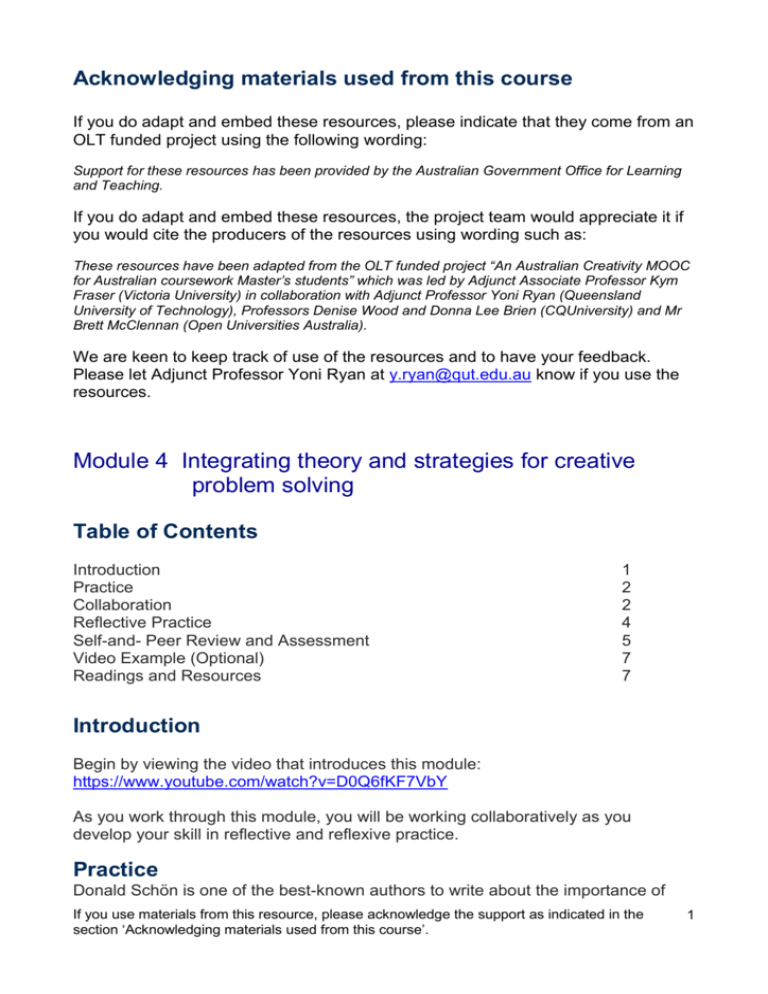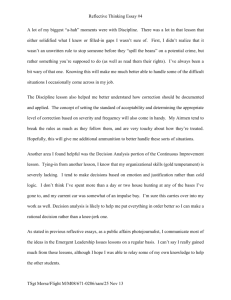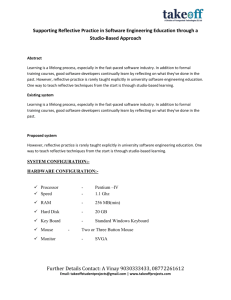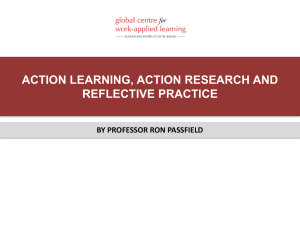Module 4 - Learning & Teaching
advertisement

Acknowledging materials used from this course If you do adapt and embed these resources, please indicate that they come from an OLT funded project using the following wording: Support for these resources has been provided by the Australian Government Office for Learning and Teaching. If you do adapt and embed these resources, the project team would appreciate it if you would cite the producers of the resources using wording such as: These resources have been adapted from the OLT funded project “An Australian Creativity MOOC for Australian coursework Master’s students” which was led by Adjunct Associate Professor Kym Fraser (Victoria University) in collaboration with Adjunct Professor Yoni Ryan (Queensland University of Technology), Professors Denise Wood and Donna Lee Brien (CQUniversity) and Mr Brett McClennan (Open Universities Australia). We are keen to keep track of use of the resources and to have your feedback. Please let Adjunct Professor Yoni Ryan at y.ryan@qut.edu.au know if you use the resources. Module 4 Integrating theory and strategies for creative problem solving Table of Contents Introduction Practice Collaboration Reflective Practice Self-and- Peer Review and Assessment Video Example (Optional) Readings and Resources 1 2 2 4 5 7 7 Introduction Begin by viewing the video that introduces this module: https://www.youtube.com/watch?v=D0Q6fKF7VbY As you work through this module, you will be working collaboratively as you develop your skill in reflective and reflexive practice. Practice Donald Schön is one of the best-known authors to write about the importance of If you use materials from this resource, please acknowledge the support as indicated in the section ‘Acknowledging materials used from this course’. 1 reflection in professional practice. In his much cited book, The Reflective Practitioner (1983), Schön introduces the concepts of "reflection-in-action", and "reflection-on-action" which involves "thinking on one's feet" to reflect on our experiences, connect with our feelings, and focus on the theories we employ. Reflexive practice, on the other hand, is a process by which we question our assumptions and the assumptions of existing theories and practices to "expose contradictions, doubts, dilemmas, and possibilities" (Cunliffe, 2004, p. 414). As Cunliffe (2004) explains "Whereas reflective analysis is concerned with a systematic searching for patterns, logic, and order, critically reflexive questioning opens up our own practices and assumptions as a basis for working toward more critical, responsive, and ethical action" (p. 415). Creative practitioners therefore need to be both reflective and reflexive. Indeed, as the previous modules have highlighted, the very process of creative problem solving requires the ability to be reflective and reflexive, to be able to reverse assumptions, identify alternative perspectives and arrive at novel solutions that extend on existing alternatives. The ability to critique your own work and the work of others is one way in which practitioners engage in reflective and reflexive practice. Thus, in this course, you are required to engage in both self- and peerassessment to help you to develop skill in both reflective and reflexive practice. Collaboration The editors of the collection of articles generated by the Second International Conference on Teamworking assert that "so many" organisations have embraced the concept of teamwork because it is accepted as an "improved utilisation of human resources … which some claim as the most important resource organisations have, and ultimately the only competitive advantage" (Park, Harris & Collins, 2000, p. 5). Since then, management literature as well as much work on creativity insists that a team working together, whatever its size or connectivity to other teams, is the paramount structure to problem solve, and more than that – ensure the satisfaction of customers, employees and other shareholders in the venture. Creative corporations such as Apple or Dreamworks are now famous for the way they build and use teams to problem solve, promote innovation and create exciting and valued new products. We seem to be hard-wired to work together. Despite the common understanding of Darwinian natural selection in which aggressive competition ensures survival – as the most successful fighters survive to breed and pass on their individual genes while more passive, weaker strains do not – biologists from Darwin onwards have also noted that members of some species work together for outcomes that benefit the group as a whole rather than individuals. Game theorists are working with biologists (Hauert & Doebeli, 2004, p. 643) and finding that cooperative behaviour is not merely an anomaly in the evolutionary struggle, but is so central and crucial as to perhaps hold the key to the If you use materials from this resource, please acknowledge the support as indicated in the section ‘Acknowledging materials used from this course’. 2 “emergence … of life itself” (Klarreich, 2004, p. 90). Although such discussions of evolution and game theory seem remote from the creative or corporate worlds, or this course, it does highlight the fundamental centrality of cooperative behavior. In The Fifth Discipline (1990), the groundbreaking work conceptualising workplaces as complex living systems made up of collaborative teams rather than Metropolisstyle machines, Peter Senge argues that teamwork is a key reason why some organisations are able to learn, evolve and change (and thus survive and thrive), while others never progress beyond a certain stage of performance and achievement. This text was, and remains, important in business and industry contexts as Senge’s ideas are future-focused, seeking to shift corporate concentration away from profit driven, but often short-term, planning. Building on this idea, management consultants Katzenbach and Smith’s bestselling The Wisdom of Teams (1992) has become so entrenched in business and management theory that even their subtitle, Creating the High Performance Organization, has become an aim in many circles. Katzenbach and Smith’s teams, moreover, are not just any group of people who work together on a specific task or project but, rather, “a small number of people with complementary skills who are committed to a common purpose, performance goals, and approach for which they hold themselves mutually accountable” (1994, p. 45). Four essential elements are stressed in this and other work on collaborative practice: 1.complementary skills; 2.mutual accountability; 3.a common approach; and, 4.shared (and concrete) goals. Katzenback and Smiths’ major refinement of Senge’s theory is to suggest that there are levels of teams, with the members of the to-be-aspired-to peak “high performance” team not only dedicated to a common task or purpose, but also “deeply committed to one another’s personal growth and success” (1994, p. 92). Such teams, while obviously completing the task at hand, simultaneously become “vehicles for personal learning and development” (1994, p. 48). This is an attractive idea for many of us who, in the task-rich, time-poor environment of the 21st century, feel personal development and satisfaction often fall to the end of our constantly growing to-do lists. For many of us, such an ideal team is unattainable. What steps could you take as a leader to develop these four elements for collaborative creativity? Discuss in a posting to the Module Four Discussion Forum. Later work takes the next logical step in this progression, looking beyond the building of effective, but separate, workplace teams to viable ways of networking If you use materials from this resource, please acknowledge the support as indicated in the section ‘Acknowledging materials used from this course’. 3 these into a “collaborative organization” as in Beyerlein et. al.’s Beyond Teams: Building the Collaborative Organization (2002). Such an organisation, Beyerlein et al. assert, will have teamwork, communication and personal growth at its core, rather than operational goals in only some of its parts. You can find a discussion about a range of types of collaboration in this module’s reading, which is available online: Donna Lee Brien and Tess Brady, Collaborative Practice: Categorising forms of collaboration for practitioners’, TEXT, 7.2, October 2003, http://www.textjournal.com.au/oct03/brienbrady.htm Reflective Practice A core component of putting creativity into practice is being conscious and aware of your practice and processes. Reflective thinking is a component of this. Your selfand peer- assessments require you to reflect on, and assess, both your own work and contributions to this course, and those of your peers. As noted in the introduction, Schön (1983) employed the terms "reflection-inaction", and "reflection-on-action" and argued for the development of "an epistemology of practice, which places technical problem-solving within a broader context of reflective inquiry" (1983, p. 69) in response to the complexity, uncertainty and instability of professional knowledge. Reflective practice is also an important aspect of practice-led research in the creative arts (Piccini, 2002; Haseman, 2006) and design-based research, which aims to addresses complex problems in 'real' educational contexts (Reeves, 2006). Practice-led research begins with an "enthusiasm of practice" (Haseman, 2006, p. 100) and involves formative reflection on practice through the research and design process, as well as at the conclusion of the process. Similarly, design-based research involves continuous iterative cycles of design, enactment, analysis, and redesign; and documents the successes, failures and interactions in the local context to better understand the implications for applying in other contexts (The Design-Based Research Collective, 2003). Here are some links to useful material about reflective thinking and writing: QUT's 4Rs model of reflective thinking: http://www.citewrite.qut.edu.au/write/reflectivewriting.jsp Donald Schön: learning, reflection and change: http://infed.org/mobi/donald-schon-learning-reflection-change/ Reflective writing – a very brief guide: https://www.youtube.com/watch?v=X1xkFgHAWD0 Share any links you have on reflective practice via the shared Wiki. If you are interested in Donald Schön’s ideas, you might like to look at his book for If you use materials from this resource, please acknowledge the support as indicated in the section ‘Acknowledging materials used from this course’. 4 a more extended version of the above. D. A. Schon (1983). The reflective practitioner: How professionals think in action. Cambridge: Ashgate. Self-and Peer Review and Assessment A further extension to self-reflection and reflective writing (the process you have been engaging in via your progressive postings to the forum), is the process of selfreview and self-assessment. The benefits of self-review and peer-review and self-assessment and peerassessment are well documented in the literature (see Wood, 2009; Wood and Kurzel, 2008). The increasing interest in such methods has been driven by increasing recognition of the need to equip graduates with the skills required to be effective life-long learners. These skills include the ability to analyse information, problem-solve, work in teams, communicate effectively and reflect critically on their professional practice (Dochy & McDowell, 1998; Sluijsmans, Dochy, & Moerkerke, 1998; Humphreys, Greenan, & McIlveen, 1997). The benefits of these alternative forms of review and assessment as noted by several authors (Davies, 2003; Falchikov, 2003, 2004; Langan & Wheater, 2003; Sluijsmans, Dochy, & Moerkerke, 1998) include: 1. development of students’ evaluative and critical abilities (McDowell cited in Sluijsmans, Dochy, & Moerkerke, 1998); 2. increased opportunities to learn from the mistakes of peers as well as from exemplary work of others (Langan & Wheater, 2003; Race, 1998 cited in Ballantyne, Hughes, & Mylonas, 2002); 3. more integrated knowledge and a better understanding of standards required (Hanrahan & Isaacs, 2001); 4. increased confidence (Langan and Wheater, 2003; Topping et al, 2000); and 5. greater awareness of the dilemmas facing tutors in assessing student work (Hanrahan & Isaacs, 2001); development of the learner’s ability to selfevaluate and reflect on their performance and the feedback received (Falchikov, 1996; Langan & Wheater, 2003). If you are interested in reading more about this, you can find more information in the works cited above. To assist you in developing the skills listed above, your ability to reflect-in-action and reflect-on-action (Schön, 1983), as well as your ability to think critically and reflexively by questioning your assumptions (Cunliffe, 2004), we developed assessment tasks which include self and peer assessment. In completing your self assessments, think critically about what you have learned through the process and how your experience might change the way in which you If you use materials from this resource, please acknowledge the support as indicated in the section ‘Acknowledging materials used from this course’. 5 engage in problem solving in more creative ways in the future and add these reflections to the comments section of the self-assessment rubrics. In completing the peer-assessments, think about what advice you might provide your peer to enable them to be effective creative thinkers in the future. Share your advice in the comments section of the peer-assessment rubrics. Transparency and accountability Boyer (1990) argued that scholarship is a public, rather than private, activity and that it should be open to critique and evaluation by others. In this way, understanding is progressed through the scholarly activity of building new ideas, which are then open to the same processes of public scrutiny (Wood and George, 2003). Peer review and assessment is a key aspect of this approach to scholarship, and as Schulman (2002) argues, this process provides a means for assuring quality, transparency and accountability. For this reason, your self-assessments as well as your peer-assessments should be posted online in the assessment submission section. As you complete Module 4, you will need to submit assessments 2 and 3. Now view the video clip that wraps up this module: https://www.youtube.com/watch?v=n1tNVZ3HRF0 Video Example (optional) In our final in the series of optional videos, Nick and Sue discuss the merits of selfand peer-review and assessment, and how such approaches reflect the practice of critique in professional practice. (You will need to register for the Creativity Unlimited OOC in order to access this video): http://opencourses.cqu.edu.au/mod/page/view.php?id=1079 Readings and Resources Required reading: Brien, Donna Lee and Tess Brady. (2003). Collaborative Practice: Categorising Forms of Collaboration for Practitioners. TEXT: The Journal of the Australian Association of Writing Programs, 7.2, October 2003, http://www.textjournal.com.au/oct03/brienbrady.htm Suggested additional readings and resources: Ballantyne, R., Hughes, K., & Mylonas, A. (2002). Developing procedures for implementing peer assessment in large classes using an action research process. Assessment & Evaluation in Higher Education, 27(5), 427-441. Boud, D., & Falchikov, N. (2005). Redesigning assessment for learning beyond higher education.Proceedings of the HERDSA Conference, 34-41. Boud, D., & Falchikov, N. (2006). Learning-oriented assessment: principles and If you use materials from this resource, please acknowledge the support as indicated in the section ‘Acknowledging materials used from this course’. 6 practice. Aligning assessment with long-term learning. Assessment & Evaluation in Higher Education, 3(4), 399-413. Bennis, Warren and Patricia Ward Biederman. (1997). Organising Genius: The Secrets of Creative Collaboration. Cambridge, Mass.: Perseus Books. Boyer, E. (1990). Scholarship reconsidered: priorities of the professoriate. The Carnegie Foundation for the Advancement of Teaching. San Francisco: JosseyBass. Brophy, Kevin. (1998). Creativity : Psychoanalysis, Surrealism and Creative Writing. Carlton, Vic. : Melbourne University Press. Caves, Richard E. (2000). Creative Industries : Contracts Between Art and Commerce, Cambridge, Mass.; London: Harvard University Press. Cunliffe, A. L. (2004). On Becoming a Critically Reflexive Practitioer. Journal of Management Education, 28(4), 407-426. Davies, P. (2003). Peer-Assessment: No marks required just feedback?–Evaluating the Quality of Computerized Peer-Feedback compared with Computerized PeerMarking. Communities of Practice. Research Proceedings of the 10th Association for Learning Technology Conference (ALTC 2003), 8-10. Dochy, F., & McDowell, L. (1998). Assessment as a tool for learning. Studies in Educational Evaluation, 23(4), 279-298. Falchikov, N. (1996). Improving learning through critical peer feedback and reflection. Paper presented at the Different Approaches: Theory and Practice in Higher Education. Proceedings of HERDSA Conference 1996, Perth WA. Falchikov, N. (2003). Involving students in assessment. Psychology Learning and Teaching, 3(2), 102-108. Falchikov, N. (2004). Improving assessment through student involvement: practical solutions for learning in higher and further education. New York: Routledge Falmer. Goleman, Daniel. (1995). Emotional Intelligence. New York: Bantam Books. Hanrahan, S. J., & Isaacs, G. (2001). Assessing Self- and Peer-assessment: the students' views. Higher Education Research and Development, 20(1), 53-70. Haseman, Brad. A Manifesto for Performative Research Media International Australia, Incorporating Culture & Policy, No. 118, Feb 2006: 98-106. Hauert, C. and Doebeli, M. (2004) Spatial structure often inhibits the evolution of cooperation in the snowdrift game. Nature. 428, 643-646. Humphreys, P., Greenan, K., & McIlveen, H. (1997). Developing work-based transferable skills in a university environment. Journal of European Industrial Training, 21(2), 63-69. Katzenbach, Jon R. and Douglas K. Smith. (1993). The Wisdom of Teams: Creating the High Performance Organization. Boston: Harvard Business School Press. Kelley, Tom, with Jonathan Littman. (2000). The Art of Innovation : Lessons in If you use materials from this resource, please acknowledge the support as indicated in the section ‘Acknowledging materials used from this course’. 7 Creativity, New York: Currency/Doubleday. Klarreich, E. (2004) Generous players: Game theory explores the golden rule’s place in biology. Science News, 166 (4), 58-90. Langan, M., & Wheater, P. (2003). Can students assess students effectively? Some insights into peer-assessment. Learning and Teaching in Action, 2(1). Micklus, C. Samuel. (1997). Creativity + teamwork = solutions! Glassboro, NJ : Creative Competitions. Miller, P. J. (2003). The Effect of Scoring Criteria Specificity on Peer and Selfassessment. Assessment and; Evaluation in Higher Education, 28, 383-394. Park, Robert, Roger Harris and Emily Collins (eds.). (2000). Teamworking: Some International Perspectives. Flaxton, Qld.: Post Pressed. Piccini A. (2002). An historiographic perspective on practice as research, PARIP. Retrieved December 28, 2009 from http://www.bristol.ac.uk/parip/artexts.htm Pope, Rob. (2000). Creativity. London: Routledge. Reeves, T. C. (2006). How do you know they are learning? The importance of alignment in higher education. International Journal of Learning Technology, 2(4), 294-309. Schön, D. (1983). The reflective practitioner. How professionals think in action. New York: Basic Books. Schön, D. (1995). Knowing-in-action: The new scholarship requires a new epistemology. Change, 27(6), 26-34. Sluijsmans, D., Dochy, F., & Moerkerke, G. (1998). Creating a Learning Environment by Using Self-, Peer- and Co-Assessment. Learning Environments Research, 1(3), 293-319. Schulman, L. (2002). Inventing the future. In P. Hutchings (Ed.). Opening lines. Approaches to the scholarship of teaching and learning. Menlo Park: The Carnegie Foundation for the Advancement of Teaching. Senge, Peter M. (1990). The fifth discipline: The art and practice of the learning organization. New York: Doubleday/Currency. Sternberg, Robert J., James C. Kaufman, and Jean E. Pretz. (2001). The Creativity Conundrum. London: Routledge. Straus, David. (2002). How to Make Collaboration Work: Powerful Ways to Build Consensus, Solve Problems, and Make Decisions. San Francisco: Berrett-Koehler Publishers. The Design Based Research Collective. (2003) 'Design-based research: An emerging paradigm for educational inquiry', Educational Researcher, vol. 32, no. 1, pp. 5-8. Topping, K. J., Smith, E. F., Swanson, I., & Elliot, A. (2000). Formative peer assessment of academic writing between postgraduate students. Assessment & Evaluation in Higher Education, 25(2), 149-169. If you use materials from this resource, please acknowledge the support as indicated in the section ‘Acknowledging materials used from this course’. 8 Torrance, E. Paul, Mary Murdock, and David Fletcher. (c1996). Creative problem solving through role playing, Pretoria: Benedic Books. Weiner, Robert Paul. (2000). Creativity & Beyond : Cultures, Values, and Change. Albany, NY: State University of New York Press. Winer, Michael and Karen Ray. (1994). Collaboration Handbook: Creating, Sustaining, and Enjoying the Journey. Saint Paul, MN: Amherst H Wilder Foundation. Wood, D. (2009). A scaffolded approach to developing students’ skills and confidence to participate in self and peer assessment. Proceedings of the ATN Assessment Conference, Melbourne Wood, D. and Friedel, M. (2009). Peer review of learning and teaching: Harnessing collective intelligence to address emerging challenges. Australian Journal of Educational Technology, 25(1). Retrieved 21 February 2009 from http://www.ascilite.org.au/ajet/ajet25/wood.pdf Wood, D. and George, R. (2003). Quality standards in online teaching and learning: A tool for authors and developers. Proceedings of ASCILITE 2003 in Adelaide, South Australia, December 2003. If you use materials from this resource, please acknowledge the support as indicated in the section ‘Acknowledging materials used from this course’. 9





